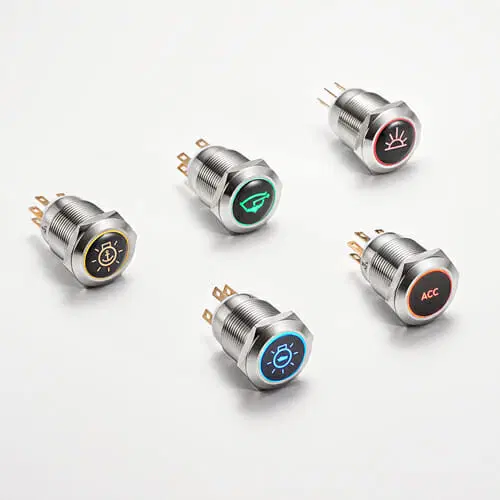Capacitive switches are electrical switches that use an electrostatic field to activate and control the flow of electricity. These switches are found in a variety of applications, including computers, cell phones, and other electronic devices.
Capacitive switches have many advantages over traditional mechanical switches. They are more resistant to shock and vibration, have a longer lifespan, and can be sealed against dust and moisture. Additionally, capacitive switches can be activated by a variety of objects, including fingers, gloves, and styluses.
Here are some key points about capacitive switches:
Operation: Capacitive switches rely on changes in the capacitance (the ability to store an electric charge) to detect user input. When an object with sufficient capacitance, such as a finger or a conductive stylus, comes in close proximity to the switch, it alters the electrostatic field and triggers the switch's response.
Durability: Capacitive switches are known for their durability. Since they have no mechanical parts to wear out or become damaged, they are more resistant to shock, vibration, and mechanical stress. This makes them suitable for applications in rugged environments or devices that experience frequent movement.
Lifespan: Due to their non-mechanical nature, capacitive switches typically have a longer lifespan compared to mechanical switches. They can endure millions of activations without significant deterioration, leading to increased reliability and reduced maintenance requirements.
Environmental sealing: Capacitive switches can be sealed against dust, moisture, and other environmental contaminants. This is because they do not require physical contact to activate, unlike mechanical switches that rely on physical pressure or movement. Sealed capacitive switches are commonly used in outdoor or industrial settings, as well as in medical devices where hygiene is crucial.
Versatile activation: One of the advantages of capacitive switches is their ability to be activated by a variety of objects, including not only fingers but also gloves, styluses, or other conductive materials. This versatility allows for more flexibility in user interactions and enables the use of different input methods depending on the specific application or user preferences.
Overall, capacitive switches offer enhanced durability, longer lifespan, and environmental sealing compared to mechanical switches. These benefits, combined with their ability to be activated by various objects, have made capacitive switches popular in a wide range of electronic devices and applications.
Applications for Capacitive Switches
Capacitive switches are used in a variety of electronic devices, from televisions and computers to cell phones and kitchen appliances. They are also found in medical equipment, automotive electronics, and aerospace applications.
A capacitive switch is a type of electronic switch that uses electrostatic capacitance to control the flow of electricity. The capacitive switch is made up of two conductive plates separated by a dielectric material. When a voltage is applied to the plates, an electrostatic field is generated. This field can be used to control the flow of current through the switch.
Capacitive switches have a number of advantages over other types of switches. They are more resistant to wear and tear, and they can be operated with very little force. They are also more precise than mechanical switches, and they can be used in applications where space is limited.
Consumer Electronics: Capacitive switches are commonly used in consumer electronics devices such as smartphones, tablets, laptops, and remote controls. They provide a sleek and modern interface, allowing for touch-sensitive controls and gestures.
Appliances and Home Automation: Capacitive switches are used in household appliances like microwave ovens, washing machines, refrigerators, and coffee makers. They offer a user-friendly interface with touch-sensitive controls that are easy to clean and maintain. Capacitive switches also find applications in home automation systems, where they can control lighting, temperature, and other functions.
Automotive Electronics: Capacitive switches are increasingly being used in automobiles for various controls, including infotainment systems, climate control, window controls, and steering wheel controls. They offer durability, resistance to environmental factors, and a sleek design that complements modern car interiors.
Medical Equipment: Capacitive switches are utilized in medical devices and equipment due to their ability to be sealed against moisture and contaminants. They are used in applications such as patient monitors, medical imaging systems, diagnostic equipment, and laboratory instruments.
Industrial and Machinery Controls: Capacitive switches are employed in industrial settings for machinery controls and human-machine interfaces. They can be found in control panels, operator interfaces, and touch-sensitive displays used in manufacturing equipment, process automation, and industrial machinery.
Aerospace and Defense: Capacitive switches are used in aerospace and defense applications where reliability and ruggedness are essential. They can be found in aircraft cockpits, control panels, avionics systems, and military equipment.
Gaming and Entertainment: Capacitive switches are utilized in gaming consoles, arcade machines, and virtual reality devices, providing responsive touch controls and enhanced user experiences.
These are just a few examples of the many applications where capacitive switches are used. Their durability, precision, compact size, and versatility make them a preferred choice in numerous industries where touch-sensitive and reliable controls are required.
